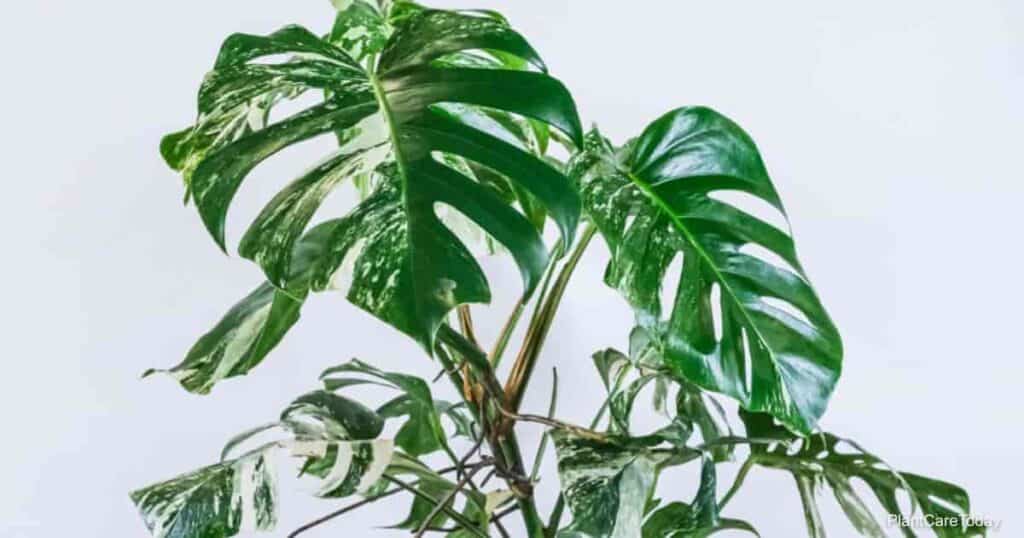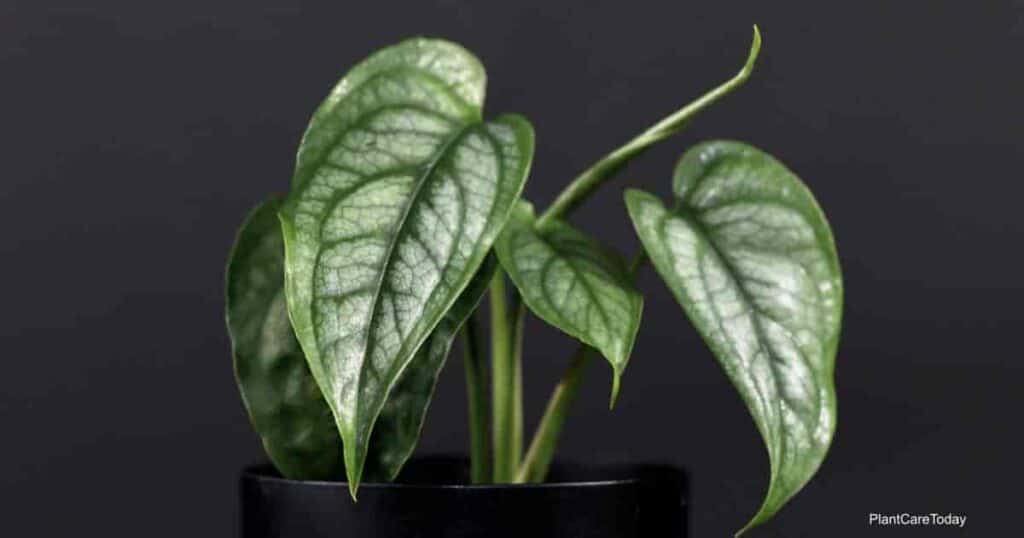Monstera (mon-STER-uh) is a type of Evergreen tropical vine or shrub hailing from Central America.

These plants are well known for the natural holes (fenestrations) that appear in their large, attractive leaves. This trait accounts for their across-the-board common name, Swiss Cheese Plant.
- Why Do Monstera Leaves Have Holes?
- Why is it Called Monstera?
- How Many Species Are There of Monstera?
- Where and How is Monstera Used in the Landscape, Garden, or Home?
- 10 Popular Types of Monstera Plants
- Monstera Adansonii
- Monstera Deliciosa
- Monstera Siltepecana
- Monstera Obliqua
- Monstera Dubia
- Monstera Thai Constellation
- Monstera Standleyana
- Monstera Epipremnoides
- Monstera Minima (Mini Monstera)
- Monstera Borsigiana
- Monstera Obliqua
- Monstera Karstenianum
- Monstera Acuminatum
- Monstera Subpinnata
- Esqueleto Monstera
- Monstera Siltepecan
Why Do Monstera Leaves Have Holes?
The theory is that the purpose of these holes is to capture the sun flecks on the forest floor more easily.
The large spread of the leaves and the many openings may allow the plant to make the most of a limited amount of sun.
The Monstera Genus has become the go-to choice when it comes to beautifying your homes and living spaces.

These stunning houseplants have captured our eyes and hearts with their rich, green, and luxurious foliage.
Monstera is a member of the Aroid or Araceae family of plants. Among Aroids, Monstera is unusual in that these plants produce edible fruit. This is especially true of Monstera deliciosa.
Kept as a houseplant, Monstera will seldom flower or produce fruit. Yet, in their native setting of Central America and Mexico, Monstera fruits have been valuable to the indigenous people for many centuries.
Monstera plants have only been a houseplant since early in the 20 century.
Why is it Called Monstera?
The genus name is probably a contraction of the word monster. It means monster-bearing and refers to the plants’ large and unusual dark green leaves.
How Many Species Are There of Monstera?

Only a few types of Monstera are available as houseplants or grown in the landscape in tropical settings. Yet, there are 45 recognized Monstera species in existence.
Where and How is Monstera Used in the Landscape, Garden, or Home?
For the most part, people keep Monstera as showy, large-leaved houseplants. They do well indoors in bright, warm, humid settings.
When kept indoors, Monstera needs a light, airy, peat-based substrate. Keep your Monstera in a setting that provides bright, indirect light, consistent warmth, and humidity.
Overwatering can lead to root rot, while underwatering may cause the plant to become stressed and develop yellow leaves.

Monsteras typically thrive in moderate to high humidity. A humidity level of 50-60% is ideal. You can maintain humidity by using a humidifier, placing a tray of water near the plant, or misting the leaves regularly.
Keep Monstera regularly watered throughout the growing season. Allow the soil to dry slightly between waterings. During the cooler months, fall through winter, reduce watering.
If your plant is one of the many types that enjoy climbing, provide a moss pole or trellis for the aerial roots to cling to.
If you happen to live in a tropical setting in USDA hardiness zones 10 through 12, you can use Monstera in the landscape year-round.
These plants are typically understory plants in tropical rainforests. They thrive in tropical and semitropical settings where trees provide high shade.
Related: Why Is My Monstera Turning Yellow?
10 Popular Types of Monstera Plants
But how many different varieties of monster plants are there, and which one is right for you?
In this article, we will address the most popular varieties of monstera plants, from the miniature to the large.

We will tell you how to best take care of these specific varieties, how easy they are to get a hold of, and how much they might cost.
Monstera Adansonii
Monstera adansonii is a small variety that likes to climb. Still, it is unnecessary to give it a pole or trellis to let the stem climb since it is small and remains relatively compact.

This type of Monstera does very well when kept as a trailing plant or in a hanging basket.
It has a very pretty frilly appearance because the fine fenestration of the heart-shaped leaves makes them lacy rather than holey.
Monstera Deliciosa
Monstera deliciosa is a tremendous example of this popular type of plant. Its leaves are leathery, green, deeply lobed, and huge.

You may also hear this plant referred to as the Split Leaf Philodendron because of the deep lobes in the leaves. It is not a philodendron.
It is a vigorous climbing plant that will clamber rapidly up a tree in a tropical setting. The leaves of this plant can grow to an enormous 3′ x 3′ feet. When growing monstera outdoors in direct sunlight, the vines may reach a length of 30′ feet.
Monstera deliciosa can live indoors, with its growth controlled through judicious pruning. It is wise to provide this plant with a trellis or a pole to climb.
Deliciosa has both variegated and green leaf varieties.
Related: Where Do New Leaves Grow On Monstera?
Monstera Siltepecana
Monstera siltepecana is also known as the Silver Fox. It is a stunning example of this attractive type of tropical plant.

In its juvenile form, it looks very different from what it does in its mature form. When it is young, it has solid leaves. As it grows older, it develops the fenestration for which Monstera are so well known.
Additionally, the juvenile leaves are lance-shaped and silvery with deep green veins. As the plant matures, the leaves broaden and become deep green altogether.
This type of Monstera is very popular as a houseplant and does well in a terrarium.
Monstera Obliqua
Monstera obliqua: This is quite an unusual and beautiful plant and is also hard to find. You may only ever see this type of Monstera in a botanical garden. Its leaves are fragile with many fenestrations.
Monstera Dubia
Monstera dubia: From South America and Central America, this plant makes a beautiful addition to any collection. This type of Monstera has three completely different and unique foliage stages.

- At the juvenile stage, the leaves of this plant are a couple of inches long and oval. The base of the leaves is deep green, but the body of the leaf is variegated in silvery gray.
- In the second stage, the leaves develop very small fenestrations.
- Ultimately, the leaves lose their silvery-gray variegation and become entirely green. Their scent is intense, and their size is approximately 1′ foot long.
Monstera Thai Constellation
Monstera Thai constellation: This variety is prevalent because it has very unusual, splashy coloration. The variegated leaves make them appear speckled or star-strewn.
These plants are rare and difficult to find. Indeed, cuttings may cost as much as a hundred dollars. Mature plants may sell for as much as a thousand dollars.
These plants do well with regular Monstera care, but a bit more indirect sunlight helps bring out the attractive variegation.
Monstera Standleyana
Monstera standleyana: Another name for this plant is the Five Holes plant, oddly because it does not have fenestrations. Instead, it has solid, variegated, oblong leaves.

You may hear this plant referred to as a philodendron, but it is of an entirely different genus. These plants like a bit more shade than other types of Monstera.
Monstera Epipremnoides
Monstera epipremnoides: This Monstera variety has enormous leaves with many holes. As the plant matures, the shape of the leaves changes.
In the juvenile stage, the leaves have many fenestrations.
As the leaves mature, these perforations extend to the edges and cause a leaf shape resembling palm trees’ pinnate leaves.
Although this plant has huge leaves, it has a compact height of just over 1′ foot.
Monstera Minima (Mini Monstera)
Monstera minima (aka Rhaphidophora Tetrasperma): This plant hails from Malaysia and the southern parts of Thailand. Its two common names are:
- Dwarf Monstera
- Monstera Jenny
The vines of this fast-growing plant may ramble 6′ – 12′ feet, but the leaves stay very small. It is easy to control the length of the vines with judicious pruning, thus making it a popular indoor plant.
This plant is an easy keeper and does well when given a moss pole or trellis to climb.
Monstera Borsigiana
Monstera borsigiana looks very much like Monstera deliciosa, and many plant experts believe the two plants are the same. The difference, if any, is that borsigiana is a smaller version of Monstera deliciosa.

It grows a bit faster, but differences are otherwise indistinguishable.
Monstera Obliqua
Monstera Obliqua: This rare species is more sensitive and requires higher humidity levels and consistent care to thrive.
Variegated Monsteras (e.g., ‘Thai Constellation,’ ‘Albo-Variegata’, and ‘Aurea-Variegata’): Variegated varieties may need more light than their non-variegated counterparts, as the variegated parts of the leaves do not photosynthesize as efficiently.
Monstera Karstenianum
Monstera karstenianum also known as Monstera Peru. Climbing species with medium green leathery, quilted leaves. Mature leaves develop lacy veins with a deep green hue.
Monstera Acuminatum

Monstera acuminatum looks similar to Monstera adansonii the Swiss cheese vine but with smaller leaves. The leaf shape is more oval, and the leaf size when mature, is smaller.
Monstera Subpinnata
Monstera subpinnata is native to Colombia to Bolivia. Its foliage is unique compared to other Monstera species and almost looks palm-like. The plant is an amazing choice for indoors if you can get your hands on it!
Esqueleto Monstera
Esqueleto Monstera epipremnoides ‘Esqueleto’ Monstera Esqueleto goes through a crazy kind of transformation on maturity.
This rare Monstera species also looks similar to Monstera Adansonii in its younger stage, but the leaves tend to perforate much more when they grow.
Monstera Siltepecan
Monstera siltepecana (Silver Monstera) This silvery beauty is a Monstera disguised as a full-leafed vine. With a gorgeous metallic sheen on the leaves, it’s a chic choice for the home.
In its juvenile form, it looks a lot like a Philodendron (and certainly climbs like one), but once Monstera siltepecana has fully matured, it will eventually develop holes in the leaf towards the center and mostly lose the coloring.
